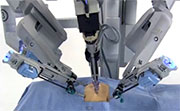Completely intracorporeal robotic level III inferior vena cava tumor thrombectomy viable
TUESDAY, Aug. 4, 2015 (HealthDay News) — Completely intracorporeal robotic level III inferior vena cava tumor thrombectomy is feasible, according to a report published recently in The Journal of Urology.
Inderbir S. Gill, M.D., M.Ch., from the University of California Institute of Urology in Los Angeles, and colleagues present the initial series of completely intracorporeal robotic level III inferior vena cava tumor thrombectomy cases. Nine and seven patients underwent robotic level III inferior vena cava thrombectomy and level II thrombectomy, respectively. The entire operation was performed robotically. An “inferior vena cava-first, kidney-last” robotic technique was developed to minimize the chances of intraoperative inferior vena cava thrombus embolization.
The researchers found that all 16 robotic procedures were successful, with no incidence of open conversion or mortality. The median primary kidney cancer size was 8.5 cm for level III cases, and inferior vena cava thrombus length was 5.7 cm. The median operative time was 4.9 hours, blood loss was estimated at 375 cc, and hospital stay was 4.5 days. Surgical margins were negative in all cases. No intraoperative complications and one postoperative complication occurred. All patients were alive at a median of seven months of follow-up. The level III cohort trended toward greater inferior vena cava length, operative time, and blood loss, compared with the level II cohort.
“Larger experience, longer follow-up, and comparison with open surgery are needed to confirm these initial outcomes,” the authors write.
Several authors disclosed financial ties to the medical device industry.
Copyright © 2015 HealthDay. All rights reserved.








